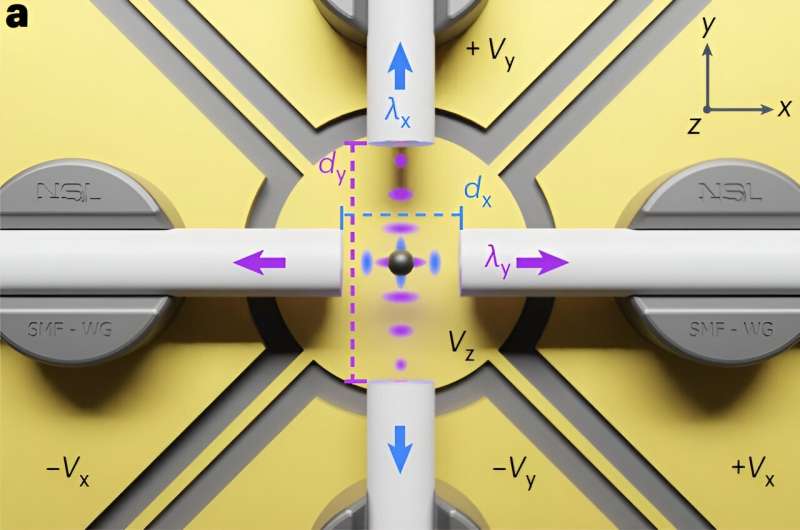
The team’s chip-raising platform. a, The upper optical layer consists of two orthogonal pairs of single-mode split optical fibers. One of the pairs (along y) creates a standing wave at λy = 1,550 nm, while the second pair (along x) creates a standing wave at λx = 1,064 nm. The distances between the fibers are dx = 80 μm and dy = 160 μm. A particle (black) is trapped at the intersection of the two standing waves. Light scattered by the particle in the fiber, represented by the arrows, is used for displacement detection. The four fibers are positioned over an array of planar electrodes used to apply active feedback cooling to charged particles via electrical forces: right and left electrodes for feedback along x, top and bottom for feedback along y, and center electrode for feedback along z . b, Figure of the levitation chip showing the planar electrodes, the four optical fibers, the fiber assemblies near the center, and the wire connections from the chip to the corner PCB. c, Optical fiber positioned in a mechanical mount fabricated via two-photon polymerization and used to bond and hold the fibers in place. Credit:Nanotechnology of nature (2024). DOI: 10.1038/s41565-024-01677-3
Levitating microscopic objects in vacuum and controlling their movements while suspended was first demonstrated several decades ago. Since then, various research groups have been working on new approaches to control vacuum-raised objects in vacuum with greater degrees of freedom.
While most experiments performed so far have relied on optical techniques, some teams have recently begun using hybrid experimental platforms that combine concepts rooted in atomic physics. These hybrid platforms enable greater control over the movement of lifted objects, unlocking new possibilities, such as force and torque sensing or precise acceleration.
Researchers at ETH Zurich recently demonstrated high-vacuum levitation of a silica nanoparticle on a photonic-electric hybrid chip. Their proposed experimental platform, described in a paper published in Nanotechnology of naturewas found to enable robust lift-off, accurate position detection, and dynamic control of the nanoparticle in vacuum.
“Isolating from the environment and precisely controlling mesoscopic objects, vacuum levitation has evolved into a versatile technique that has already benefited various scientific fields, from force sensing and thermodynamics to materials science and chemistry,” Bruno Melo, Marc T .Cuairan and theirs. colleagues wrote in their paper.
“It also holds great promise for advancing the study of quantum mechanics in the unexplored macroscopic regime.”
Despite recent advances in vacuum lift-off and control of particle motion, most previously introduced experimental methods rely on complex strategies and/or large equipment. This severely limits their real-world applications, making them impractical for developing new technologies.
Thus, several researchers have attempted to miniaturize vacuum levitation platforms using electrostatic and optical traps. The levitation achieved using most of their proposed approaches, however, was not robust enough to be applied to limited equipment, such as cryostats and portable devices.
Melo, Cuairan and co-workers presented a new hybrid photonic-electric platform that enables robust lifting, position detection and dynamic control of a nanoparticle on a chip. In contrast to other platforms, their proposed method does not require large lenses and optical equipment.
“We demonstrate high-vacuum levitation and motion control of a silica nanoparticle on the surface of a hybrid optical-electrostatic chip,” wrote Melo, Cuairan and their colleagues. “By combining fiber-based optical trapping and position-sensitive detection with cold damping through planar electrodes, we cool down particle motion to a few hundred phonons.”
In initial tests, the team’s proposed on-chip vacuum lifting and motion control platform achieved outstanding results, with signal-to-noise ratios and optical displacement detection capabilities comparable to those of other device-based approaches. large optical. When they combined their platform with planar electrodes for active feedback cooling, the researchers were also able to cool the silica nanoparticle and reduce its motion in 3D.
The new approach to on-chip vacuum lifting and motion control, presented by this team at ETH Zurich, may soon open up new opportunities for quantum research and technology development. In their future studies, Melo, Cuairan and their colleagues plan to continue to improve their platform, for example, by using refractive microantennas to further increase the detection sensitivity and to integrate more sophisticated optical elements (e.g. eg fiber cavities).
“We envision our fully integrated platform to be the starting point for on-chip devices that combine integrated photonics and nanophotonics with precisely engineered electrical potentials, increasing control over particle motion toward complex state preparation and readout,” Melo, Cuairan and their colleagues. has written
More information:
Bruno Melo et al, Vacuum levitation and on-chip motion control, Nanotechnology of nature (2024). DOI: 10.1038/s41565-024-01677-3
© 2024 Science X Network
citation: Demonstration of vacuum levitation and motion control on an optical-electrostatic chip (2024, July 2) Retrieved July 2, 2024 from https://phys.org/news/2024-07-vacuum-levitation-motion-optical- electrostatic. html
This document is subject to copyright. Except for any fair agreement for study or private research purposes, no part may be reproduced without written permission. The content is provided for informational purposes only.